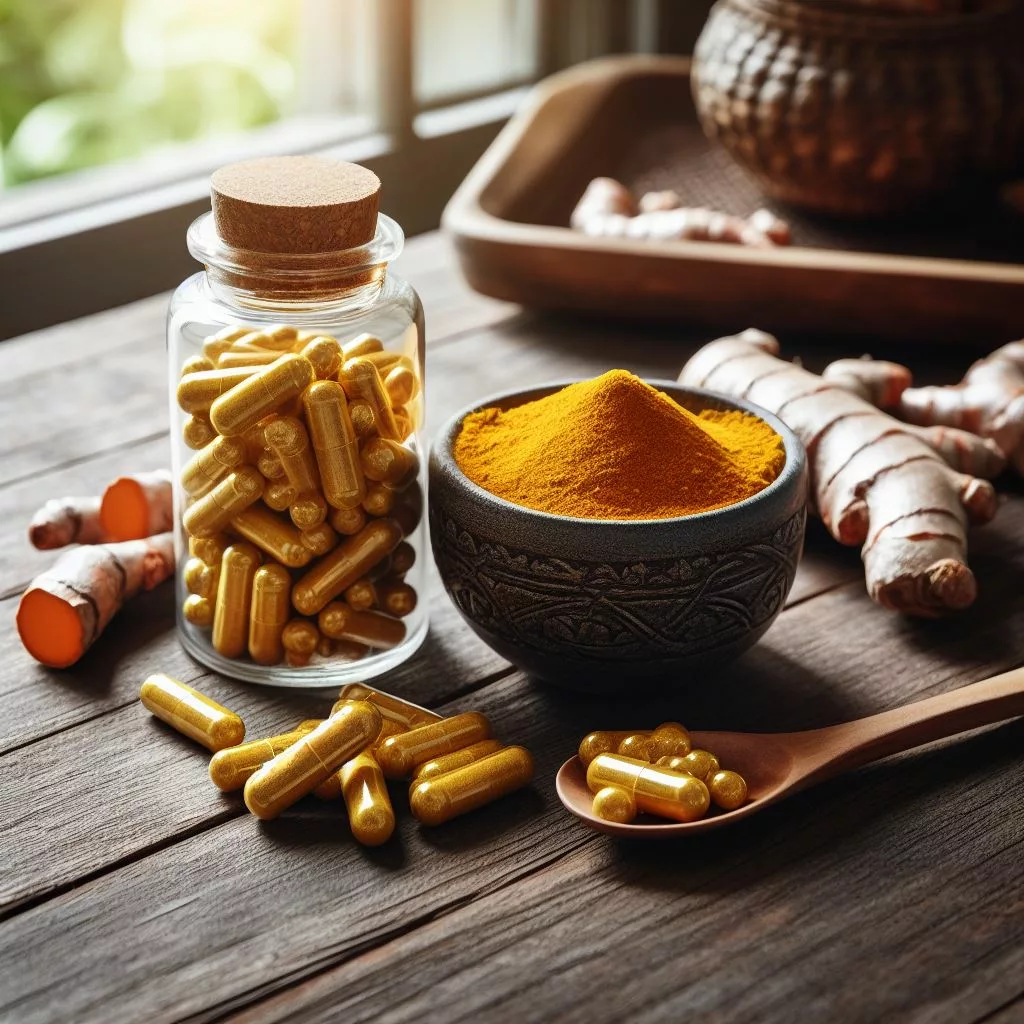
Introduction.
If you are someone who suffers from fibrosis, you know how debilitating this condition can be. Fibrosis is a term used to describe the formation of excess connective tissue in an organ or tissue due to injury or disease. This kind of condition can lead to scarring and impaired organ function.There are natural remedies that may help alleviate symptoms and potentially even reverse the damage caused by fibrosis. One such remedy is turmeric or haldi, a spice with potent anti-inflammatory and antioxidant properties.
Turmeric has been used for traditional medicine to treat ailments, including inflammation. It contains a compound called curcumin, which has been shown to have numerous health benefits. It has powerful antioxidant properties that help protect against oxidative stress, which can contribute to the development of the disease.
Additionally, curcumin has anti-inflammatory effects that may help reduce inflammation in the body and prevent further damage from occurring. We are about to explore the best ways to consume turmeric for fibrosis for you to potentially reap its healing benefits and improve your overall health and well-being.
Understanding Fibrosis and Turmeric’s Healing Properties
Turmeric’s healing properties are like a soothing balm for damaged tissues caused by fibrosis. One of the many benefits that it offers is its prevention, thanks to its potent anti-inflammatory and antioxidant effects.In fibrosis, the body produces excess connective tissue fibers, leading to scar formation in organs such as the liver, lungs, heart, and kidneys. Curcumin, has been shown to inhibit this process by reducing inflammation and oxidative stress.
This herb can help prevent liver fibrosis by inhibiting the activation of stellate cells – cells responsible for producing excess collagen in response to liver injury. Curcumin has also been shown to reduce lung fibrosis caused by radiation therapy or pulmonary infections. Its anti-inflammatory effects also make it beneficial in preventing cardiac and kidney fibrosis. To reap turmeric’s maximum benefits for fibrosis prevention, it’s best consumed with black pepper or piperine – a compound found in black pepper that enhances curcumin absorption. You can add turmeric powder to your meals or take supplements containing standardized amounts of curcumin. However, before starting any supplement regimen, it’s important to consult with your healthcare provider first.
Incorporating turmeric into your diet may help prevent the disease by reducing inflammation and oxidative stress in various organs. Its active ingredient, curcumin, has been shown to inhibit connective tissue fiber production and scar formation in organs such as the liver, lungs, heart, and kidneys. To maximize its benefits for prevention, consume turmeric with black pepper or take supplements containing standardized amounts of curcumin after consulting with your healthcare provider. In his book <HEALING WONDERS OF PLANTS > JC Kurian indicates that the herb can also treat rheumatism and pain of the facial nerves.
Turmeric Supplements

This high-potency turmeric pill is enhanced with bioperine. Bio-Schwartz turmeric formula has 1500mg of turmeric curcumin with 95% standardized curcuminoids per serving and 10mg of bioperine (black pepper, curcumin with black pepper), aiding in enhanced absorption and bioavailability. If you’re considering taking the supplements, there are a few important points to keep in mind.
Firstly, supplements can offer numerous benefits, such as reducing inflammation and supporting overall health. However, it’s crucial to follow dosage recommendations and consult with a healthcare professional if you have any underlying health conditions or concerns.
Additionally, while generally safe for most people, potential side effects of the supplements may include digestive issues or interactions with certain medications.
Benefits of Supplements
Taking supplements is like putting fuel in a car; it provides the necessary nutrients to support the body’s natural healing processes. When it comes to this herb’s supplements, there are various types available in the market such as capsules, powders, and extracts. It’s important to choose a supplement that contains high levels of curcumin, which is responsible for turmeric health benefits. When choosing a brand, it’s essential to look for one that’s been tested by third-party organizations for purity and potency. This ensures that you’re getting a product that meets high-quality standards and doesn’t contain harmful additives or contaminants. Amazon is another great resource because they offer more in-depth explanations. Overall, incorporating the supplements into your daily routine can be a beneficial way to support fibrosis treatment and overall health.
Dosage Recommendations
To ensure you’re getting the right amount of turmeric for its potential health benefits, it’s important to follow recommended dosages from a trusted source. Taking up to 500 mg of curcuminoids orally three times daily is for up to two months is generally considered to be safe. However, higher doses may cause gastrointestinal issues such as nausea and diarrhea. Amazon also recommends a dosage of 2 tablets per serving and a glass of water. Also include physical exercises to get best results. It’s also important to consider possible interactions when using the supplements. The herb may interact with certain medications such as blood thinners and antiplatelet drugs, so it’s crucial to discuss with your healthcare provider if you’re taking any prescription medication before adding its supplements into your routine.
Additionally, while turmeric has shown promising results in its effectiveness for fibrosis treatment, further research is needed to fully understand its potential benefits and safety concerns.
Potential Side Effects
While turmeric has been shown to have potential health benefits, it’s important to be aware of its possible side effects before incorporating it into your diet. One of the main concerns with the herb is its impact on liver function. Studies have indicated that high doses of it may lead to liver damage or interfere with liver function, particularly when taken in conjunction with other medications or supplements that affect the liver. It’s therefore important to monitor your liver function regularly if you’re taking high doses of turmeric or using it for extended periods.
Another possible side effect of turmeric consumption is gastrointestinal upset. Some individuals may experience nausea, diarrhea, or stomach pain when taking the supplements or consuming large amounts of turmeric in their diets. If you experience any gastrointestinal symptoms while taking turmeric, it may be helpful to reduce your dose or avoid using it altogether. Additionally, individuals who are pregnant should exercise caution when using turmeric due to a lack of research regarding its safety in these populations. And for those breastfeeding should avoid it. As with any supplement or medication, it’s important to consult with a healthcare professional before starting regular use and be aware of any contraindications or interactions that may exist with other medications you’re taking.
Cooking with Turmeric
If you’re looking to incorporate it into your diet, cooking with it is a great way to start. There are many recipes out there that feature this powerful spice as a key ingredient, from curries to smoothies. Remember that it can stain surfaces and fabrics, so be cautious while using it and clean any spills promptly. Start with smaller amounts of the spice in your recipes, and adjust according to your taste preferences. Enjoy experimenting with turmeric in various dishes to discover new flavors and culinary delights. To get the most out of it, it’s important to know the best ways to cook with it and how to maximize its benefits.
Recipes for Incorporating Turmeric into Your Diet

Spice up your meals with these tasty recipes that incorporate spice into your diet, helping to combat fibrosis. If you’re looking for a quick and easy way to add more of it into your daily routine, try making a turmeric smoothie.
Simply blend together some frozen fruit, almond milk, Greek yogurt, and a teaspoon of ground turmeric for a refreshing and healthy drink. You can also add other anti-inflammatory ingredients, such as ginger or cinnamon, to enhance the health benefits.
If you prefer snacking throughout the day, try making some turmeric-infused snacks. Roasted chickpeas are an excellent option – simply toss them in olive oil and sprinkle with salt and the spice before baking until crispy. Another great snack idea is homemade popcorn seasoned with nutritional yeast and turmeric for a savory twist. These snacks are not only delicious but also provide valuable nutrients that can help prevent fibrosis. So go ahead and experiment with different recipes incorporating this wonder spice – you’ll be amazed at the difference it can make in your health!
Best Ways to Cook Turmeric
Now that you’ve got some delicious turmeric recipes in your arsenal, let’s talk about the best ways to cook this vibrant spice.
- Golden Milk or Haldi Tea: Make a warm and comforting beverage by combining turmeric with milk (or plant-based milk) and other spices like cinnamon, ginger, and honey. Simmer the ingredients together for a flavorful and soothing drink.
- Curries and Stews: Haldi is a common ingredient in many Indian, Thai, and Middle Eastern curries and stews. It adds vibrant color and a warm, earthy flavor. Sauté haldi with other spices in oil or ghee before adding vegetables, proteins, or legumes to your curry or stew.
- Rice and Grain Dishes: Add haldi to rice or other grain dishes to infuse them with color and a subtle flavor. Sauté haldi with onions and spices before adding rice or grains and cooking them together. This works well for dishes like turmeric rice, pilaf, or biryani.
- Roasted Vegetables: Toss chopped vegetables like cauliflower, sweet potatoes, or carrots with olive oil, salt, and turmeric. Roast them in the oven until golden and tender. The haldi adds a beautiful hue and enhances the flavor of the roasted vegetables.
- Smoothies and Juices: Add a pinch of turmeric powder or grated fresh turmeric root to your smoothies or juices for an extra nutritional boost. Pair it with fruits like mango, pineapple, or citrus for a delicious and vibrant combination.
- Salad Dressings and Marinades: Incorporate turmeric into homemade salad dressings or marinades. Combine haldi with ingredients like lemon juice, olive oil, honey, and herbs to create flavorful dressings or marinades for meats, poultry, or vegetables.
- Eggs and Omelets: Sprinkle the herb into scrambled eggs or omelets to add color and a subtle flavor. It pairs well with ingredients like spinach, onions, and cheese for a delicious and nutritious breakfast option.
When it comes to health benefits, incorporating this herb into your diet through cooking is one of the easiest ways to reap the rewards. Not only does it add an earthy and warm flavor to your dishes, but studies have shown that consuming turmeric may help reduce inflammation and improve brain function. So why not experiment with different ways of cooking with this superfood spice and see how you feel? Your taste buds (and body) will thank you!
Tips for Maximizing Turmeric’s Benefits
Getting the most out of the herbs health benefits, it’s worth noting that adding a pinch of cinnamon to your turmeric tea or latte can help regulate blood sugar levels and improve digestion. Cinnamon contains compounds that enhance insulin sensitivity and reduce inflammation in the body.
- Choose high-quality turmeric: Opt for organic haldi powder or fresh haldi root from reputable sources to ensure purity and quality.
- Combine the herb with black pepper: Black pepper contains piperine, a compound that enhances the absorption of curcumin, the active compound in haldi. When using it in recipes or supplements, consider adding a pinch of black pepper to increase its bioavailability.
- Consume the herb with fat: Curcumin is fat-soluble, so consuming turmeric with a source of fat can enhance its absorption. Add it to dishes cooked with oils, such as coconut oil or olive oil, or include it in recipes that contain healthy fats like avocados or nuts.
- Heat enhances bioavailability: Heat can increase the solubility of curcumin in fat, potentially enhancing its absorption. Consider cooking the herb in recipes or using it in warm beverages like turmeric tea or golden milk.
- Pair haldi with complementary spices: Some spices, such as ginger and cinnamon, have synergistic effects with turmeric and may enhance its potential benefits. Incorporate these spices into your meals or beverages along with it for added flavor and potential health effects.
- Consider haldi supplements: The supplements, such as curcumin capsules, can provide higher concentrations of curcumin than using it in cooking. When choosing a supplement, look for one that contains a standardized amount of curcumin and consider consulting with a healthcare professional for personalized advice.
- Practice moderation: While the herb is generally safe for consumption, it’s important to practice moderation and avoid excessive intake. Follow recommended dosages for supplements and be mindful of the amounts used in cooking or recipes.
- Consult with a healthcare professional: If you have specific health concerns or are considering turmeric for therapeutic purposes, it’s advisable to consult with a healthcare professional or a registered dietitian who can provide personalized guidance based on your individual needs and health condition.
Remember that this spice is not a cure-all, and its benefits may vary from person to person. It is always recommended to incorporate turmeric as part of a balanced diet and healthy lifestyle, alongside evidence-based medical treatments and recommendations from healthcare professionals.
Turmeric Tea:
For a soothing and delicious way to consume the herb, you can try brewing yourself a cup of turmeric tea. Haldi tea is often consumed for its potential health benefits. Curcumin, the active compound in it, is known for its anti-inflammatory and antioxidant properties. Some suggest that curcumin may have positive effects on conditions such as arthritis, digestive disorders, and certain chronic diseases. However, more research is needed to establish the efficacy of the herb’s tea specifically.
Enhancing absorption: Curcumin has low bioavailability on its own. However, combining haldi with black pepper or a source of fat can help enhance its absorption. Adding a pinch of black pepper or consuming it tea with a meal that contains healthy fats, such as coconut milk or ghee, may aid in curcumin absorption.
Considerations: While turmeric tea is generally safe for consumption, it is advisable to consult with a healthcare professional, particularly if you have any underlying health conditions or are taking medications. It may interact with certain medications, and high doses may have potential side effects. It’s also important to note that turmeric tea should not be considered a substitute for medical treatments recommended by healthcare professionals.
Whether you drink it first thing in the morning or before bed at night, sipping on a warm cup of homemade turmeric tea can provide numerous health benefits while also being a deliciously comforting treat. So why not give this tasty beverage a try today?
Choosing the Best Method for You
If you’re looking for a way to consume turmeric for fibrosis, there are several alternatives to this spice tea that you can choose from. It’s important to consider what works best for you and your lifestyle when deciding on the best method of consumption. One popular alternative is adding turmeric powder to your meals. This can easily be done by sprinkling it onto vegetables, rice, or meat dishes. You can also mix it into salad dressings or sauces for added flavor and health benefits.
Another option is taking turmeric supplements in capsule form. This allows for easy dosing and avoids any potential taste aversions that may come with consuming the spice directly. However, it’s important to make sure you’re purchasing high-quality supplements from a trusted source. Ultimately, the best method of consuming the herb for this type of disease will depend on your personal preferences and lifestyle. Consider trying out different methods to see what works best for you and consult with a healthcare professional if necessary. With its numerous health benefits, incorporating this powerful spice into your daily routine can have positive impacts on your overall well-being.
Frequently Asked Questions
Are there any potential side effects of consuming turmeric for fibrosis?
When it comes to managing fibrosis with turmeric consumption, there are potential side effects to be aware of. While turmeric is generally considered safe when used in moderation, consuming too much can lead to gastrointestinal issues such as nausea and diarrhea. It may also interfere with certain medications or supplements. In terms of dosage for fibrosis management, there isn’t a clear consensus yet but some have suggested taking 500-2000mg per day of curcumin.
How much turmeric should be consumed daily to see improvement in fibrosis symptoms?
To see improvement in fibrosis symptoms, it’s recommended that you consume approximately 1-3 grams of the spice daily. This amount can vary depending on the severity of fibrosis. It’s also important to note that consuming the spice alone may not be enough to fully treat the disease and should be used in conjunction with other treatments as prescribed by a doctor. As for the optimal time for consuming the spice, it’s suggested to take it with meals in order to increase its absorption into the body. Overall, incorporating its consumption into your daily routine may provide some benefits for those suffering from fibrosis but should always be done under medical supervision.
Can turmeric be used as a replacement for traditional medical treatments for fibrosis?
Imagine this spice as a shining star in the sky, beckoning you to try it as an alternative treatment for fibrosis. It’s important to note that the spice, or its active compound curcumin, should not be considered as a replacement for traditional medical treatments for this disease.Fibrosis is a complex condition that often requires a comprehensive treatment approach, which may involve medications, lifestyle modifications, and other interventions based on the specific underlying cause and severity of it. When incorporating it into your routine, consider consuming it through supplements or adding it to your meals for maximum absorption.
What is the best time of day to consume turmeric for maximum benefits?
To maximize the benefits the herb’s consumption, it’s recommended to consume it in the morning or early afternoon. This allows for better absorption and utilization by your body throughout the day. Curcumin has low bioavailability and is poorly absorbed by the body. However, combining curcumin with certain ingredients or methods can enhance its absorption. For example, consuming turmeric with black pepper, which contains piperine, has been shown to increase curcumin’s bioavailability. Although there isn’t a specific research study addressing the time to consumption of this spice studies have reviewed that the phase I clinical trials have shown that curcumin is safe even at high doses (12 g/day) in humans but exhibit poor bioavailability.
Are there any specific types of fibrosis that turmeric is more effective in treating?
As the saying goes, “an ounce of prevention is worth a pound of cure.”When it comes to the treatment of fibrosis, the spice has been shown to be effective for various types of fibrosis. Curcumin has shown potential anti-fibrotic effects in various fibrotic conditions, the effectiveness may vary depending on the specific type of fibrosis. It’s important to note that the research in this area is still evolving, and more studies are needed to establish the efficacy of the herb in treating specific types of fibrosis. The recommended dosage for consuming this herb varies depending on the individual’s health condition and medical history. But generally speaking, taking 500-1000 mg of curcumin per day is considered safe and effective for most people.
Conclusion
Congratulations! You now have a good understanding of how to consume turmeric to fight fibrosis. Keep in mind that the best way to take this spice varies from person to person, depending on their preferences and needs. Did you know that, according to a study conducted by the University of Maryland Medical Center, curcumin (the active ingredient in turmeric) can help reduce inflammation and prevent fibrosis in certain organs? This is just one example of the many benefits that turmeric has to offer. By incorporating this powerful spice into your diet, whether through supplements or cooking methods such as adding it to tea or meals, you can potentially improve your overall health and fight against fibrosis.
Remember, always consult with your healthcare provider before starting any new supplement regimen or making significant.

